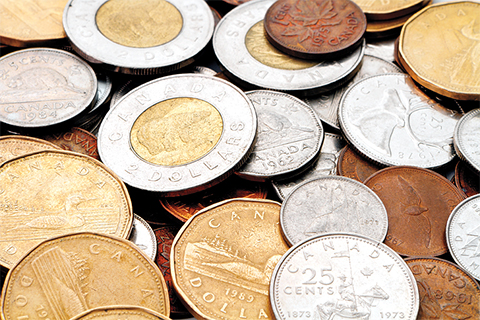In February, Canadians will say goodbye (or good riddance) to the penny, and, later in 2013, will start using polymer $5 and $10 bills. U of T Magazine editor Scott Anderson spoke to economics professor Jack Carr about the art and science of making change.
The Bank of Canada has announced it will phase out the penny. Why now?
John Palmer, an economist at Western University, has been telling the Bank of Canada to get rid of the penny for the past 30 years. Pennies are a nuisance. How many people nowadays would stop to pick up a penny off the ground? A century ago, you could pay for a chocolate bar with two or three pennies; now they have no real purchasing power. And they cost the bank 60 per cent more to produce than they’re worth. The question is why the bank took so long! The answer is that it probably just came down to inertia. In any institution, there’s always risk with change.
How does the bank determine which denominations should be bills and which should be coins?
Before the Bank of Canada introduced the loonie, in 1987, a dollar bill lasted only about nine months in circulation. So the bank weighed the cost of continually collecting all the old bills, destroying them and replacing them with new ones every nine months against a dollar coin, which costs more to produce but lasts 30 to 50 years or longer. The coin won out. People may not like loonies and toonies because they put a hole in your pocket, but they’re a lot more durable.
Will the nickel disappear anytime soon? Is the bank cooking up plans to replace the $5 bill with the “foonie”?
Prices today are about six times what they were in the early 1960s, so a nickel doesn’t buy much these days, either. It may make sense to get rid of it now! The real challenge for the bank is to determine the optimal distribution of notes and coins to minimize transaction costs for the Canadian economy. And it must revisit this question every so often as prices change and non-cash transactions become more prevalent. But no, I don’t think we’ll be getting a $5 coin anytime soon. Consumers don’t want one.
Why does the bank change the design of our bills so frequently?
People need to have faith in their currency, so the bank normally would not want to change how the currency looks. But they have to do so in order to stay ahead of counterfeiting, which is a big problem.
Hence the polymer bank notes?
Yes, you can include security features on the polymer that you can’t on our current bills. The new notes have transparent windows containing raised text, hidden numbers and metallic images. These are extremely difficult to replicate, and relatively easy for consumers and businesses to check. But the polymer is also intended to give the notes greater longevity; they’re expected to last two-and-a-half times as long as the old cotton paper ones.
There are a lot more non-cash transactions now. How does that affect the bank’s decisions about how much money to print?
The amount of currency – bills and notes – in circulation is strictly determined by the needs of trade. If the retail banks ask for more, because, for example, it’s Christmastime and people are taking out more cash, the Bank of Canada will give them more.
Will the amount of money in circulation decline over time as non-cash transactions become more popular?
Thirty years ago, people thought we’d become a cashless society. It hasn’t happened. And there’s a reason for this. For small transactions, cash has lower transaction costs than cheques or credit. And unlike cheques or credit, cash can’t be traced. There are plenty of people who don’t want others to know what they’re paying for. Criminals come to mind, people who engage in black market transactions, and people who want to avoid taxes. That’s not going to change.
Recent Posts
U of T’s 197th Birthday Quiz
Test your knowledge of all things U of T in honour of the university’s 197th anniversary on March 15!
Are Cold Plunges Good for You?
Research suggests they are, in three ways
Work Has Changed. So Have the Qualities of Good Leadership
Rapid shifts in everything from technology to employee expectations are pressuring leaders to constantly adapt







2 Responses to “ Tossing a Coin ”
I believe the title should have stated the Royal Canadian Mint. The Royal Mint strikes the U.K.'s coinage, last time I checked.
Thanks, now corrected.